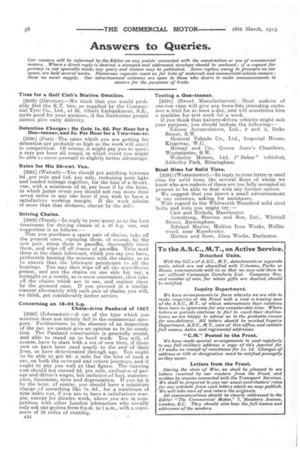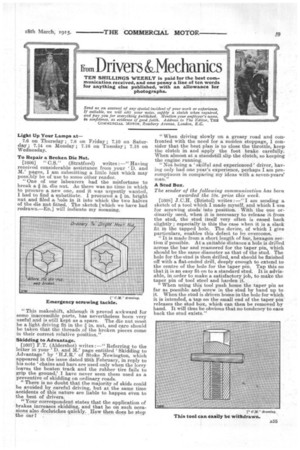To the A.S.C., M.T., on Active Service.
Page 20

Page 21

If you've noticed an error in this article please click here to report it so we can fix it.
Dta.ched Units.
Will the O.C.s of A.S.C„ M.T„ detachments or separate units, which are not classified with C)Iumns, Parks or Bases, communicate with as so that we may add them to our official Campaign Comforts List. Company Nos. and number of men, for whom gifts are desired, should bc notified,
Inquiry Department.
We have arrangements in force whereby we are able to make inquiries at the Front with a view to tracing men of the A.S.C., mi.., of whose whereabouts their relatives have been in ignorance for any considerable time. Where letters or parcels continue to fart to reach their destinations, we are happy to advise as to the probable reason for non-delivery. All letters should be marked Inquiry Department, A.S.C., MT., care of this office, and contain full names, dates, and regimental addresses.
Posted to the Front.
We have made special arrangements to post regularly to any full military address a copy of 'this -journal for 13 weeks on receipt of remittance for Is. Id. Changes of address or title or designation must be notified promptly as they occur.
Letters from the Front..
During the staleof War, we shall be ,pleased to see letters received by. our readers from the Front, and written by anyone connected with the Transport Services, We shall be prepared to pay our usual contributors' rates for any extracts from such letters which we may publish. We will take care ofand return the originals.
All communications should be clearly addressed to the Editor "The Commercial Motor," 7, Rosebery Avenue, London, E.C. They should also bear the full names and addresses of the senders.
Light Up Your Lamps at 7.6 on Thursday ; 7.8 on Friday ; 7.10 on Saturday; 7.14 on Monday ; 7.16 on Tueoday ; 7.18 on Wednesday.
To Repair a Broken Die Nut.
[1606] " C.S." (Stratford) writes :—" Having received considerable assistance from your 'D. and M.' pages, I am submitting a little hint which may possibly be of use to some other reader.
"One of our labourers had. the misfortune to break a in. die nut. As there was no time in which to procure a new one, and it was urgently wanted, I had to find a substitute. I procured a I in. bright nut and filed a. hole in it into which the two halves of the die nut fitted. The sketch [which_ we have had redrawn.—En.] will indicate my meaning.
"This makeshift, although it proved awkward for some inaccessible parts, has nevertheless been very useful and is still kept as a spare. The die nut must be a light driving fit in the I in. nut, and care should be taken that the threads .of the broken pieces come in their correct relative position."
Skidding to Advantage.
[1607] F. T. (Aldershot) writes Referring to the letter in your D. and M.' page entitled 'Skidding to Advantage' by H.J.R.' of Stake Newington, which appeared in the issue dated 25th February, in reply to his note 'chains and bars are used only when the lorry leaves the beaten track and the rubber tire fails to grip the ground,' I have never seen them used as a preventive of skidding on ordinary roads.
" There is no doubt that the majority of skids could be avoided by careful driving, but at the same time accidents of this nature are liable to happen even to the best of drivers.
"Your correspondent states that the application of brakes increases skidding, and that he on such occasions also declutches quickly. How then does he stop the car 7
"When driving slowly on a greasy road and confronted with the need for a sudden stoppage, I consider that the best plan is to close the throttle, keep the clutch in and apply the foot brake carefully. When almost at a standstill slip the clutch, so keeping the engine running. "Not being a 'skilful and experienced' driver, having only had one year's experience, perhaps I am presumptuous in comparing my ideas with a seven-years' man."
A Stud Box.
The sender of the following communication has been awarded the 10s. prize this week.
[1608] J.C.H. (Bristol) writes :—"I am sending a sketch of a tool which I made myself, and which I use for screwing studs into position. With the one ordinaiily used, when it is necessary to release it from the stud, the stud itself very often is eased back slightly ; especially is this the case when it is a slack fit in the tapped hole. The device, of which I give particulars, enables this defect to be overcome.
"It is made from a short length of bar, hexagon section if possible. At a suitable distance a hole is drilled across the bar and rearnerecl for the taper pin, which should be the same diameter as that of the stud_ The hole for the' stud is then drilled, and should be finished off with a fiat-ended drill, deeply enough to extend to the centre of the hale for the taper pin. Tap this so that it is an easy fit on to a standard stud. It is advisable, in order to make a satisfactory job, to make the taper pin of tool steel and harden it.
"When using this tool push home the taper pin as far as passible and screw in the stud by hand up to it. When the stud is driven home in the hole for which it is intended, a tap on the small end of the taper pin releases the stud box, which can then be removed by hand. It will thus be obvious that no tendency to ease back the stud exists."






















